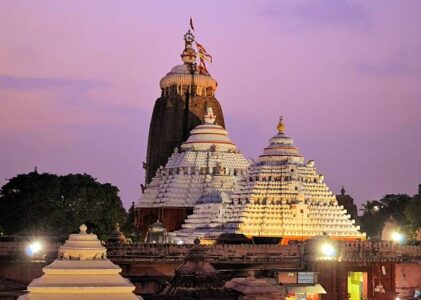1. Introduction
Jagannath Temple in Puri, Odisha, is one of the most revered pilgrimage sites in India. Known for its grand architecture, deep-rooted history, and vibrant rituals, the temple attracts millions of devotees annually. This blog explores the fascinating history, architectural marvel, and tourism highlights of this spiritual haven, making it a must-visit for travelers.

2. Overview of Jagannath Temple
The Jagannath Temple is dedicated to Lord Jagannath, an incarnation of Lord Vishnu. Located in Puri, one of the four sacred Dhams in India, the temple stands as a symbol of Hindu devotion and spirituality. Its towering spires and intricate carvings captivate visitors.
- Internal Link: Link to previous travel-related posts (e.g., nearby temples or spiritual places) on Travel Atlas.
3. History of Jagannath Temple
Built in the 12th century by King Anantavarman Chodaganga Deva of the Eastern Ganga dynasty, the Jagannath Temple holds a profound place in Indian history. The temple has witnessed centuries of rulers, religious reformers, and devotees, and its significance has only grown with time.
Notable Historical Milestones:
- Construction during the reign of the Eastern Ganga dynasty.
- Contributions of King Ananga Bhima Deva.
- Mughal invasions and subsequent protection by local rulers.
4. Architecture and Significance
The architecture of Jagannath Temple reflects the grandeur of Kalinga-style temples. Standing over 214 feet tall, it dominates the skyline of Puri. The temple complex is vast, with multiple structures, each with its unique carvings and designs.
Architectural Highlights:
- The main tower (Shikhara).
- The intricately carved Jagamohana (assembly hall).
- Pattachitra-style paintings adorning the walls.
The temple’s architecture symbolizes a mix of religious and cultural significance, embodying centuries-old traditions.
5. Rituals and Traditions
One of the most striking aspects of the Jagannath Temple is its elaborate and unique rituals. Every day, a series of ceremonies are performed for Lord Jagannath, his brother Balabhadra, and sister Subhadra.
Notable Rituals:
- Sahanamela: When devotees can get close to the deities.
- Nabakalebara: The sacred renewal of the wooden idols every 12-19 years.
- Mahaprasad: The temple’s holy offering, considered the food of the gods.

6. The Famous Rath Yatra
The Rath Yatra, or chariot festival, is the most iconic event associated with Jagannath Temple. Celebrated annually in June or July, it draws massive crowds from all over the world. During this event, the deities are placed in huge chariots and taken to the Gundicha Temple, symbolizing their visit to their aunt’s house.
Highlights of Rath Yatra:
- The massive chariots, built anew each year.
- Devotee participation in pulling the chariots.
- The significance of the Gundicha Temple.
7. Best Time to Visit Jagannath Temple
The best time to visit Jagannath Temple is during the winter months (October to February), when the weather is pleasant. The Rath Yatra festival is another ideal time to experience the temple in all its glory, but it can be crowded.
- Seasonal Recommendations: Avoid the summer months due to the intense heat in Puri.
- Travel Tips: Book accommodations early during festival seasons.
8. Jagannath Temple as a Tourist Destination
Apart from being a spiritual center, Jagannath Temple is a key tourist destination in India. Visitors come not just for religious reasons but also to experience the rich culture, architecture, and local traditions of Odisha.
Tourist Highlights:
- Explore the Puri Beach, just a short walk from the temple.
- Visit Chilika Lake, Asia’s largest saltwater lagoon, nearby.
- Discover the local markets offering handicrafts and Pattachitra paintings.
9. Cultural Significance
Jagannath Temple is more than a place of worship. It is a cultural hub, where devotees from all over India come to celebrate, participate in rituals, and experience the rich history of Odisha. Its cultural influence is seen in Odisha’s dance forms, music, and local art.
10. Local Attractions Around Jagannath Temple
While visiting Puri, there are several attractions you can explore in addition to Jagannath Temple:
Nearby Attractions:
- Konark Sun Temple: A UNESCO World Heritage site.
- Gundicha Temple: Associated with Rath Yatra.
- Puri Beach: A popular destination for both relaxation and spirituality.
11. Tips for Visiting Jagannath Temple
Visiting Jagannath Temple can be a once-in-a-lifetime experience. To ensure a smooth visit, here are some helpful tips:
- Dress modestly: Traditional attire is recommended.
- Plan your visit: Mornings are usually less crowded.
- Stay hydrated: Especially if visiting during the summer months.
- Be respectful: Cameras and phones are not allowed inside the temple premises.
12. Conclusion
Jagannath Temple is a spiritual, cultural, and architectural marvel that offers a deeply enriching experience to all who visit. Whether you’re drawn by its rich history, intricate rituals, or simply looking to explore one of India’s holiest sites, a visit to this temple in Puri is a journey into the heart of India’s religious traditions.
Internal Links: Be sure to add internal links to relevant articles on Travel Atlas, such as nearby temples or spiritual places. For example, linking to articles on Konark Sun Temple or Puri Beach will enhance user experience and SEO.
This structure, paired with careful use of the keywords you’ve provided, will ensure your blog is both informative and optimized for search engines.

